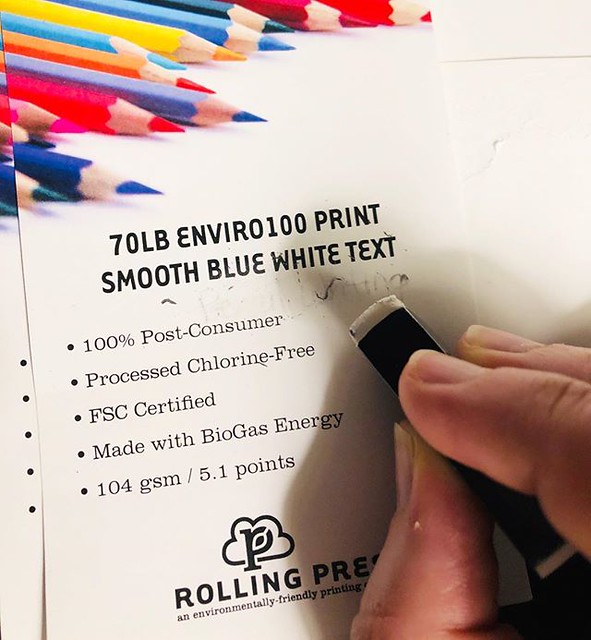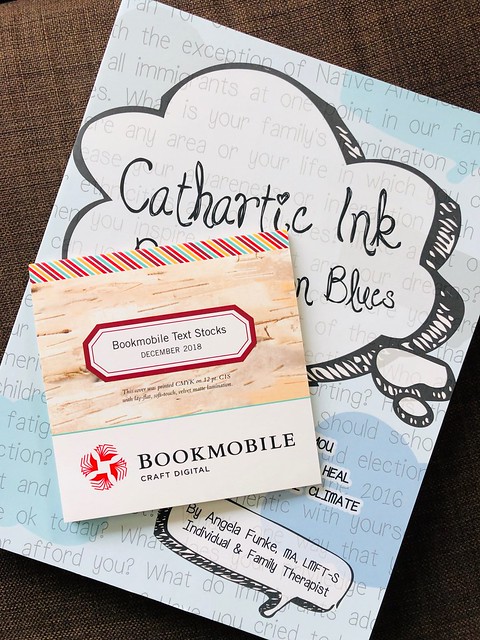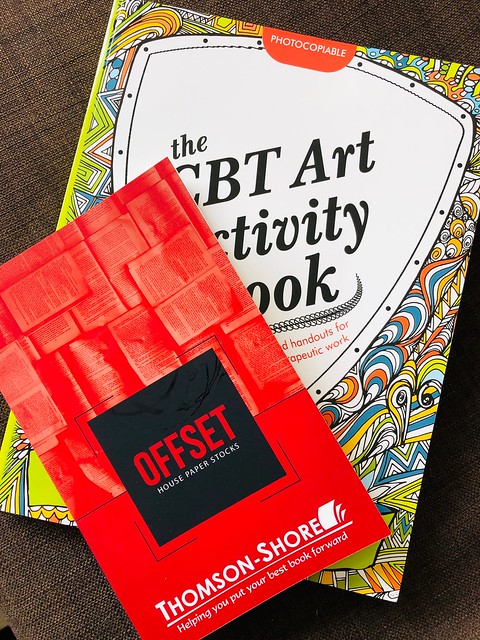When I decided to self-publish the Pricing Workbook for Creatives instead of trying to go through traditional publishers, one of the things I also retained control over was how it would be printed, and who it would be printed by. Of course, control also means added responsibility and workflow steps to make it all happen, but after so many years of running an entire creative business largely on my own, I'm no stranger to managing a lot of things.
Luckily I didn't have any expectations of how long this process would take.
I knew some things would just take time, and getting paper samples from a variety of printers has certainly taken a bit more time than I might have guessed. In some cases, samples arrived in one week from contacting a printing house, in others, it was three weeks just for paper samples to arrive for testing as workbook paper to write and erase on.
I care about how it feels to actually do the work and write on the paper, and I want to make sure it's a good experience that feels good to keep working on, no matter how many times it needs to be erased.
There have also been about 50% dropped inquiries, where I've requested a quote and received half follow-up on a quote or total radio silence. Obviously I'm going to give my business to the responsive printing companies that care about communication, rather than those that don't follow-thru. I also learned that some paper samples looked really promising online, but once I had them in my hands, I realized they weren't going to work due to the actual texture and surface of the paper, which is exactly why I needed to make sure I received some samples and not just price quotes. Apparently I'm super picky about paper!

(Paper sample from Rolling Press based in Brooklyn, NY. Great for writing & erasing on!)
I would like to be conscious about my printing options by choosing recycled paper products and non-toxic soy-based earth friendly inks.
Unfortunately, these options are still more expensive than traditional options with less recycled content and toxic inks. Luckily, I think the material in the workbook is valuable enough to make it worth the cost of paying more to be earth conscious. I would certainly sleep better at night knowing that people are writing out their future dreams for a passionate creative life on the recycled papers of old corporate reports full of wasteful ideas that require squashing people's dreams for corporate profits. OK, that may be just a fantasy version of recycled paper use, but it still feels so much more satisfying than thinking about ripping a bunch of old trees out of Indonesia.

(Paper sample from Greener Printer based in Port Richmond, CA. Better for magazine style photo printing with satin surfaces than for gritty workbook printing.)
The hardest part is the financial sustainability of printing on eco-conscious papers while also working with traditional publishing and distribution options.
One printing quote I received from a shop in Los Angeles that had been recommended by a New York art book printer was so high that I literally think I lost my ability to breathe when I looked at the quote. They were 3x more than any other quote- which meant they were 9x more than traditional book printing, and I wondered who they are actually working for at those rates? Maybe they've cornered all the Oscar and Grammy printed program business? I don't know... but I do know I can't choose a printer who will make the workbook unaffordable to access, just so it can be printed sustainably.
The best eco-friendly printers sent not just paper samples, but entire book samples of products that were similar in shape, size, and binding to the one I'm creating.
Huge kudos to the book printing houses below for following up on my request for a quote and samples with not just paper samples, but full size workbook samples similar in size, paper type, and binding type to what I was requesting, based on other projects they've already printed in their shop. I think they know that if we have a great relationship right out of the inquiry gate, I'm going to do all of my follow-up book printing with them- so it's smart move to go a little further up front.

(Book & Paper Sample from Bookmobile based in Minneapolis, MN. Maximum 30% post-consumer waste paper options.)

(Book & Paper Sample from Thomson-Shore based in Dexter, MI. Offers 100% post-consumer waste paper options as well as FSC certified mixed PCW options.)
The biggest financial sustainability challenge is combining the cost of eco-friendly printing with Amazon online distribution.
Once I finally got to a place of finding some good potential printing options and selected my ideal printer based on the printing samples, I started pricing out the costs for the printing and shipment, and how much it would leave remaining after Amazon takes their own cut of a book.
This is where Amazon starts to look like the big bad wolf blowing everyone's houses down. Amazon is a double-edged sword. On one hand, they cut through a lot of the hassle of working with traditional publishing houses and they give authors more control over updates and changes on their books as well as reaching international markets online. On the other hand, Amazon is taking 65% of each e-book sale, and about the same percentage after all is said and done of each Print-on-Demand book as well. Ouch. This margin is still better than what a traditional publisher would take for a traditional book sale through hundreds of different retail stores, so to an Author, it might also appear to be a better deal than not self-publishing.
Cha-ching for Amazon! Ouch for the Environment.
There's also no option to request eco-friendly Print-on-Demand options. If this was addressed, it could be a huge shift in publishing house practices to make the demand for eco-friendly papers, inks, and binding options more affordable if implemented at the enterprise level of Amazon, Barnes & Noble, and other print-on-demand providers. What a massive social change that might create to also make it profitable to employ more people to do more waste-recycling efforts around the world.
If Amazon can't print eco-friendly, I thought, what if I skipped the traditional Print-on-Demand and sold the book as an Amazon FBA seller? The Amazon cut would be less than the Print-on-Demand option, however, the added cost of using an eco-friendly printing option PLUS the Amazon commission and storage of a large print run of books actually makes it financially unsustainable to work with an eco-friendly option while distributing with Amazon.
FFFFFFFFFFFUCK.
There goes the eco-friendly print plan for online distribution with Amazon.
If I were going to print a bunch of eco-friendly books, I'd have to find another way to sell them. I'd have to find a way that didn't take such a large cut of the remaining profit margin after printing them with sustainable papers and inks. Essentially, I'd only be able to sell environmentally friendly editions as part of workshops, conferences, classes, or learning experiences where I'd haul a bunch of them to provide in person.
I have no plans to become my own distribution center for one-off purchases of a book.
This is how Amazon and Print-on-Demand options end up winning the online book game and the book profit game in the end, and how they force more books to be printed on papers that are not FSC Certified or post-consumer waste content, with inks that are not environmentally friendly.
Even at the price of a $35 book, it is financially unsustainable to print an environmentally friendly workbook and make it available for distribution through Amazon. There needs to be enough profit margin to buy the next round of books to be printed as well as shipping, and with Amazon, that's simply not an option.
However, if doing an in-person workshop, where the book is just part of the workshop materials, it's sustainable to go with eco-friendly printing because the only other cost to consider is shipping and it can be folded into the cost of goods to produce the workshop or class, which would definitely be more than $35 in order to be sustainable to run as an in-person workshop.
The unhappy ending.
Since I will be traveling internationally the first year that the Pricing Workbook for Creatives is in production, I will not be able to manage storage of printed books, nor will I be offering workshops in person that will need bulk printed copies of the books. I'll be giving in to Amazon's business engine, because it's what is going to help the most people while I travel, but not being able to print environmentally friendly is the part that makes me sad.
Hopefully, hearing stories from people around the world who use the workbook to launch their dream projects will make me hate Amazon less. I hope so. I need some light at the end of the Amazon distribution tunnel.
I promise to continue fighting and finding a way to make eco-friendly printing easier to access.
This blog post is just the beginning of the journey to sharing resources around how we can overcome the financial issues involved with eco-friendly printing and focus on finding a better way toward greater financial sustainability with options that offer environmental sustainability. For now, I have to do what I can to make sure the first year of this book is fiscally sustainable so that it can support the artists and creatives that it needs to serve. My hope is that next year, I can focus more on workbook offerings that make use of eco-friendly printing sources, as a way to inspire others to do more of the same with the work they create.
The Pricing Workbook for Creatives is scheduled to be released in Kindle format on May 5, 2019.
Sign up if you would like to be on the early release notification: http://pricingworkbookforcreatives.com
Luckily I didn't have any expectations of how long this process would take.
I knew some things would just take time, and getting paper samples from a variety of printers has certainly taken a bit more time than I might have guessed. In some cases, samples arrived in one week from contacting a printing house, in others, it was three weeks just for paper samples to arrive for testing as workbook paper to write and erase on.
I care about how it feels to actually do the work and write on the paper, and I want to make sure it's a good experience that feels good to keep working on, no matter how many times it needs to be erased.
There have also been about 50% dropped inquiries, where I've requested a quote and received half follow-up on a quote or total radio silence. Obviously I'm going to give my business to the responsive printing companies that care about communication, rather than those that don't follow-thru. I also learned that some paper samples looked really promising online, but once I had them in my hands, I realized they weren't going to work due to the actual texture and surface of the paper, which is exactly why I needed to make sure I received some samples and not just price quotes. Apparently I'm super picky about paper!

(Paper sample from Rolling Press based in Brooklyn, NY. Great for writing & erasing on!)
I would like to be conscious about my printing options by choosing recycled paper products and non-toxic soy-based earth friendly inks.
Unfortunately, these options are still more expensive than traditional options with less recycled content and toxic inks. Luckily, I think the material in the workbook is valuable enough to make it worth the cost of paying more to be earth conscious. I would certainly sleep better at night knowing that people are writing out their future dreams for a passionate creative life on the recycled papers of old corporate reports full of wasteful ideas that require squashing people's dreams for corporate profits. OK, that may be just a fantasy version of recycled paper use, but it still feels so much more satisfying than thinking about ripping a bunch of old trees out of Indonesia.

(Paper sample from Greener Printer based in Port Richmond, CA. Better for magazine style photo printing with satin surfaces than for gritty workbook printing.)
The hardest part is the financial sustainability of printing on eco-conscious papers while also working with traditional publishing and distribution options.
One printing quote I received from a shop in Los Angeles that had been recommended by a New York art book printer was so high that I literally think I lost my ability to breathe when I looked at the quote. They were 3x more than any other quote- which meant they were 9x more than traditional book printing, and I wondered who they are actually working for at those rates? Maybe they've cornered all the Oscar and Grammy printed program business? I don't know... but I do know I can't choose a printer who will make the workbook unaffordable to access, just so it can be printed sustainably.
The best eco-friendly printers sent not just paper samples, but entire book samples of products that were similar in shape, size, and binding to the one I'm creating.
Huge kudos to the book printing houses below for following up on my request for a quote and samples with not just paper samples, but full size workbook samples similar in size, paper type, and binding type to what I was requesting, based on other projects they've already printed in their shop. I think they know that if we have a great relationship right out of the inquiry gate, I'm going to do all of my follow-up book printing with them- so it's smart move to go a little further up front.

(Book & Paper Sample from Bookmobile based in Minneapolis, MN. Maximum 30% post-consumer waste paper options.)

(Book & Paper Sample from Thomson-Shore based in Dexter, MI. Offers 100% post-consumer waste paper options as well as FSC certified mixed PCW options.)
The biggest financial sustainability challenge is combining the cost of eco-friendly printing with Amazon online distribution.
Once I finally got to a place of finding some good potential printing options and selected my ideal printer based on the printing samples, I started pricing out the costs for the printing and shipment, and how much it would leave remaining after Amazon takes their own cut of a book.
This is where Amazon starts to look like the big bad wolf blowing everyone's houses down. Amazon is a double-edged sword. On one hand, they cut through a lot of the hassle of working with traditional publishing houses and they give authors more control over updates and changes on their books as well as reaching international markets online. On the other hand, Amazon is taking 65% of each e-book sale, and about the same percentage after all is said and done of each Print-on-Demand book as well. Ouch. This margin is still better than what a traditional publisher would take for a traditional book sale through hundreds of different retail stores, so to an Author, it might also appear to be a better deal than not self-publishing.
Cha-ching for Amazon! Ouch for the Environment.
There's also no option to request eco-friendly Print-on-Demand options. If this was addressed, it could be a huge shift in publishing house practices to make the demand for eco-friendly papers, inks, and binding options more affordable if implemented at the enterprise level of Amazon, Barnes & Noble, and other print-on-demand providers. What a massive social change that might create to also make it profitable to employ more people to do more waste-recycling efforts around the world.
If Amazon can't print eco-friendly, I thought, what if I skipped the traditional Print-on-Demand and sold the book as an Amazon FBA seller? The Amazon cut would be less than the Print-on-Demand option, however, the added cost of using an eco-friendly printing option PLUS the Amazon commission and storage of a large print run of books actually makes it financially unsustainable to work with an eco-friendly option while distributing with Amazon.
FFFFFFFFFFFUCK.
There goes the eco-friendly print plan for online distribution with Amazon.
If I were going to print a bunch of eco-friendly books, I'd have to find another way to sell them. I'd have to find a way that didn't take such a large cut of the remaining profit margin after printing them with sustainable papers and inks. Essentially, I'd only be able to sell environmentally friendly editions as part of workshops, conferences, classes, or learning experiences where I'd haul a bunch of them to provide in person.
I have no plans to become my own distribution center for one-off purchases of a book.
This is how Amazon and Print-on-Demand options end up winning the online book game and the book profit game in the end, and how they force more books to be printed on papers that are not FSC Certified or post-consumer waste content, with inks that are not environmentally friendly.
Even at the price of a $35 book, it is financially unsustainable to print an environmentally friendly workbook and make it available for distribution through Amazon. There needs to be enough profit margin to buy the next round of books to be printed as well as shipping, and with Amazon, that's simply not an option.
However, if doing an in-person workshop, where the book is just part of the workshop materials, it's sustainable to go with eco-friendly printing because the only other cost to consider is shipping and it can be folded into the cost of goods to produce the workshop or class, which would definitely be more than $35 in order to be sustainable to run as an in-person workshop.
The unhappy ending.
Since I will be traveling internationally the first year that the Pricing Workbook for Creatives is in production, I will not be able to manage storage of printed books, nor will I be offering workshops in person that will need bulk printed copies of the books. I'll be giving in to Amazon's business engine, because it's what is going to help the most people while I travel, but not being able to print environmentally friendly is the part that makes me sad.
Hopefully, hearing stories from people around the world who use the workbook to launch their dream projects will make me hate Amazon less. I hope so. I need some light at the end of the Amazon distribution tunnel.
I promise to continue fighting and finding a way to make eco-friendly printing easier to access.
This blog post is just the beginning of the journey to sharing resources around how we can overcome the financial issues involved with eco-friendly printing and focus on finding a better way toward greater financial sustainability with options that offer environmental sustainability. For now, I have to do what I can to make sure the first year of this book is fiscally sustainable so that it can support the artists and creatives that it needs to serve. My hope is that next year, I can focus more on workbook offerings that make use of eco-friendly printing sources, as a way to inspire others to do more of the same with the work they create.
The Pricing Workbook for Creatives is scheduled to be released in Kindle format on May 5, 2019.
Sign up if you would like to be on the early release notification: http://pricingworkbookforcreatives.com






